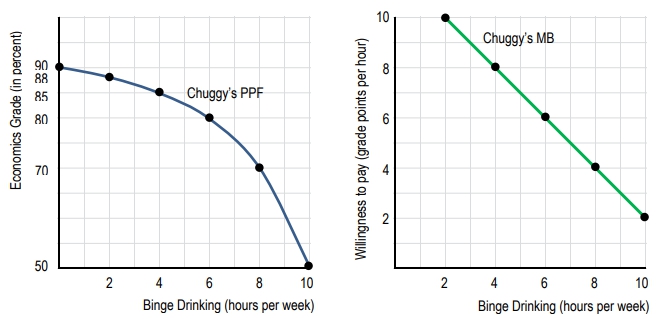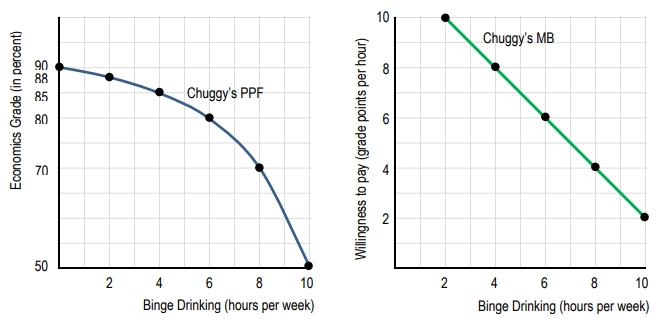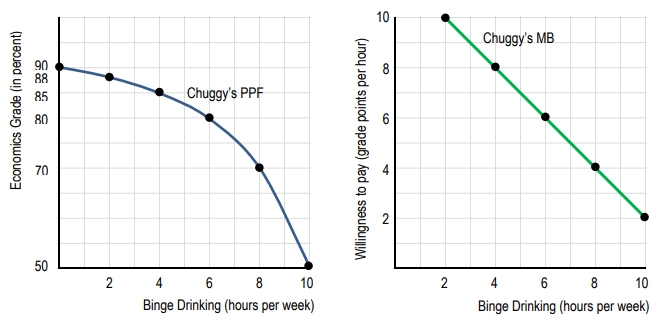So now we're going to continue with the discussion of increasing marginal opportunity costs. So when you look at a graph like you see on the left here, we've got the graph for Hipsterville, which I'm going to call here where they produce craft beer and soy cheese pizza. When we look at the graph, you see the graph has a shape that kind of bows outward, right? It's not this straight line just connecting these two points from one to the other. No. It's got this shape that bows outward, and the point of that is to describe this situation of increasing marginal opportunity costs. So the idea is that as we increase the production of one good, say soy cheese pizza, it's going to cost us more and more of the production of the other good. So the idea is as we increase the production of soy cheese pizza, it's going to become marginally more expensive.
Let’s look at this graph, and let’s see how that works here. The idea, remember when we're talking about marginal opportunity cost, what's the opportunity cost of one more? So what's it going to cost us for one more pizza in this case? So when we're at 0 and we want to move up to 1 pizza, well, when we have 0 pizzas we notice this graph goes up by 2, 4, 6, 8, 10. This spot right here is 15 on the graph, and when we move to 1, so when we create our first pizza, we are going to get less craft beer. Right? So when we had 0 pizza, we had 15 craft beers up there, and now it’s going to move us down to 14 craft beers here on the graph. So this is 6, 8, 10, 12, 14 and then 15 right there where it crosses. So what did we give up to get this first pizza? Right? We started at 15 and now we're at 14. We gave up one craft beer to get to that first pizza. Right? We had 15 craft beers, now we have 14 craft beers. The marginal cost is going to be one for that first pizza.
So now what about that second pizza? Now the marginal cost, remember it's how much for one more pizza. We already have one pizza, how much for that second one in this case? So here we started with one pizza, what happens when we move over to the second pizza? It looks like we lose two beers in this case, right. We had 14 beers, now we're down to 12 beers once we get to the second pizza. So the marginal cost of that pizza is going to be 2. When we've got one pizza, the marginal cost of the next pizza is 2.
Let’s do the same thing with the next one. So here we were at 12 beers and then we move down to this point right here which is in the middle of the graph, that's at 9 right there. So here we are giving up three beers, right. We were at 12. Now we are down to 9 beers once we have that third pizza. So our marginal cost when we have two pizzas of adding one more pizza is three beers. So that the third pizza, right?
Now let’s try the next one, right? Now we already have three pizzas, how much is that fourth one going to cost us? So we start here at 9. We’re going to find where it goes down to, and that’s right here in the middle again. Now we're at 5. So we had 9 beers, and we had to give up four of those beers to get that fourth pizza. So the marginal cost when we have three pizzas of the fourth pizza is going to be four beers in this case. Right? We had 9 beers, and we had to give up four of them to get to that fourth pizza.
And last but not least, what about when we want five pizzas? So we're at four, we want to have a fifth pizza, and the cost of that last pizza is going to be five. So notice we’ve got increasing marginal opportunity cost, right? The more we want of something, the more we have to give up. And if you were to do this the other way, you would see the same thing. We’d have to be giving up more and more pizza to get beers. Alright? Cool.




